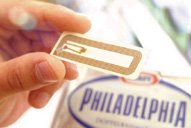RFID - A Problem Or A Solution?
August 14, 04
By Edahn Golan
Every business tries to be more efficient, sometimes by investing in a technology that will help smooth operations, prevent product loss, or improve inventory tracking. This is true for mega supermarkets and mom and pop shops alike. One such technology is RFID - Radio Frequency Identification.
 |
What Is It?
RFID is a way to collect stored information from a small tag - an RFID Tag - at short distances. The RFID tag is a small object, usually a sticker on a product, that contains an antenna and a microchip that sends a small amount of stored information such as a serial number when read by an RFID transceiver. The microchip can store about 2KB of data.
Think of it as a sort of electronic barcode. The smallest commercially available tag I know of is 0.4 mm and is as thin as a sheet of paper. Passive tags, without their own battery or power source, can be read from a distance of about 1 cm (almost half an inch) to up to 5 meters.
How Is It Used?
Think of the prospects - a diamond polisher can track a stone throughout the manufacturing process, from rough to polished gem. He can then pass the tag with the stone to the jewelry maker where it can be tracked all the way to the retailer.
More Ideas?
The very same device that will give the retailer the price of an item when making a sale will also give you all the relevant info about the diamond set in it, who made it and where, how many such items were sold, update the inventory and also set off an alarm if it leaves the premises without being checked out first.
RFID is already used with car ignition keys for extra security, library books for self checkout, triggering equipment down oil wells, and identifying pets - my dog has one under her skin, I’m grateful for it. She once wandered away and the municipal dog pound knew to bring her back to me thanks to the tag.
Alas, nothing comes easy, and with technology the common fear is with privacy issues. If the tags are left on the products, and at times consumers might not even be aware that such a tag is on a product, they could be read by anyone with an RFID reader. What increases the fear is an idea to give products globally unique codes. In that case, a reader would know what the product is that is wrapped up, in a box, in a shopping bag.
I don’t subscribe to the fear of somebody standing outside my home and scanning the entire contents to report back to some conglomerate what food the Golan family has in its refrigerator, furniture in the living room and old toys in the attic. Still, many feel uncomfortable that a database of their purchasing behavior can be created.
By the way, according to RFID Journal, there are no health risks associated with RFID since the radio waves use the low-end of the electromagnetic spectrum. Just so you know.
Links:
NRF’s extensive special report on RFID
Part I - www.smartbrief.com/latestIssue.jsp?i=14438&l=1191498
Part II - www.smartbrief.com/latestIssue.jsp?i=14578&l=1191498
RFID Journal - a site devoted to RFID and its business applications
Auto-ID Labs - a federation of research universities developing an open standard architecture for creating a seamless global network of physical objects. Geeky, I know.